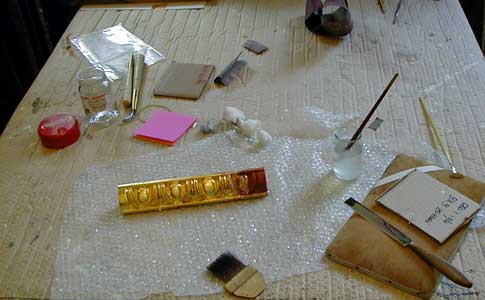Traditional Water Gilding
A step-by-step process of gilding is described below, from gesso, through bollo to gold leaf and burnishing, with examples of 3 stages in the water gilding process. Gesso is plaster of Paris, or gypsum, a pasty material spread onto a surface to prepare it for painting or gilding. Bollo is a type of clay that is applied as an undercoating on top of the gesso in the last stage prior to starting the gilding process itself.
Step 1: First gesso is applied. After the gesso has dried, two layers of each yellow and red bollo are applied. This is the final stage before the actual gilding.

Step 2: Then gold leaf is laid upon the dried red bollo using a special brush. The gold leaf is very thin and fine. Even a slight draft from an open window is enough to cause the gold leaf to elevate and be blown away. The whole process is done without touching the gold leaf with bare hands; doing so would make it disintegrate.

Step 3: After 24 hours burnishing is done using an agate stone, which is very fine, strong and smooth, in order not to scratch the gold leaf. In the image below, the fully burnished, gilded section is at the right, and the part that still needs burnishing is at the left.

Below, some tools of the trade.

|